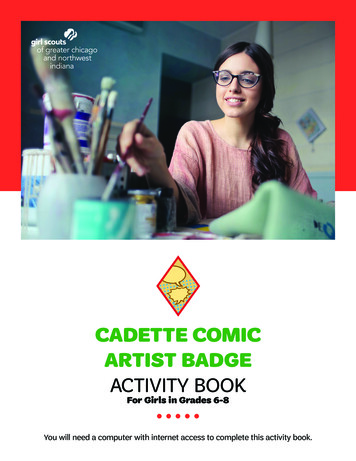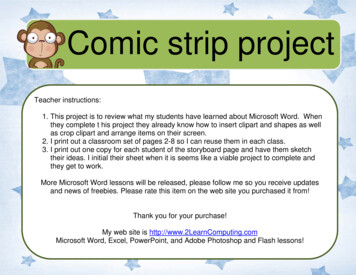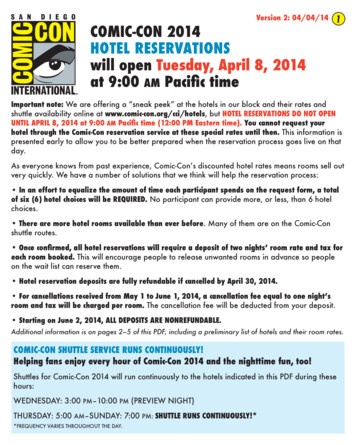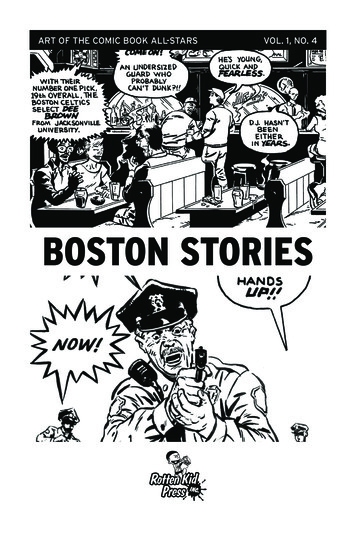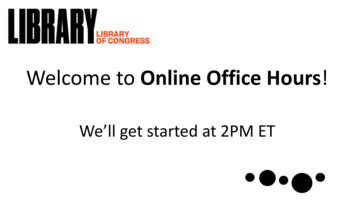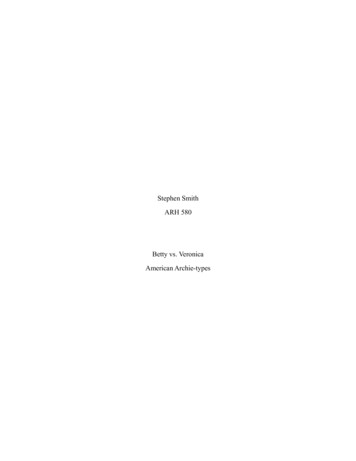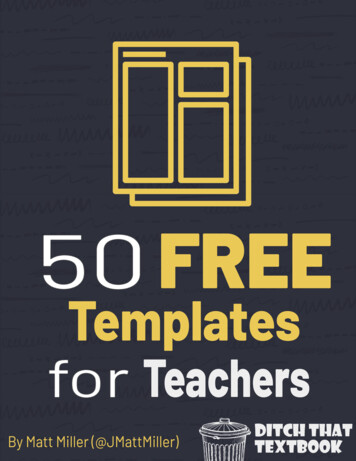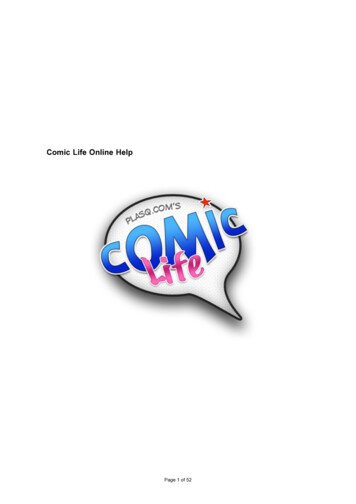
Transcription
Comic Life Online HelpPage 1 of 52
IntroductionComic Life makes creating digital comics a snap. Use Comic Life to produce high quality comics for posting onthe web, including in a movie or printing out for friends.With a comprehensive set of features, Comic Life gives you numerous ways to explore your creativity - liven upholiday snaps, tell a story, even quickly create fun and helpful "how-to" guides.Feature highlightsCoreImage filtering Turn your photos into artistic illustrations perfect for your comic.Video Capture Plug in your iSight or other video camera and grab images right alongside your comic.Custom Page Sizes Whatever page size you need Comic Life can match it.Quick Comic tool Get a head-start by selecting an iPhoto album and turning it into a laid-out comic ready forballoons and captions in one step.Digital Strip font Realistic comic lettering right from the start.Mac integration Easy publishing to the web.RSS newsfeed The easy way to share your .Mac comics with the world.Quartz rendering State-of-the-art rendering technology means smooth balloons and text.iPhoto integration Integrated access to your libraries and when you're done you can send your finished comicback to iPhoto 5 ready for turning into an high-quality book.Various page formats Design comics for all kinds of media: web, video and print.Custom lettering Freely distortable and rotatable comic lettering lets you create exciting sound effects anddramatic titles.Speech balloons All types of balloons can be easily placed and edited specifically: Speech, thought, whisper andexclamation. Other balloons are available for special situations. Balloons can be easily extended for longerspeeches and fitting into tight spaces.Captions Introduce a new scene or provide some background information with a caption.Stylesheets Easily define a consistent style for every element in your comic for a professional look.Page organizer Quickly access and reorder pages.Page templates Choose from a wide variety of page templates included in the application and easily create yourown.QuickTime export Create a movie to put on a DVD or to include in a larger video project.Email this Comic button to easily share your works of genius.Infinite undo Limited only by your computer memory.Copy and Paste Comic Life Elements into other applications.Flexible text Take advantage of the OS X text features to mix fonts and styles.Panels Create realistic layouts with panels that can automatically trim images and balloons to their edges.WYSIWYG layout What you see is what you get.Fun UI Comic Life's user interface has been designed to be fun and intuitive.The Work AreaComic Life gives you an efficient work area and user interface to create your comics.Page 2 of 52
Getting familiar with the work areaThe Comic Life work area is arranged to help you focus on creating and editing comics. The work area consists ofthe following components:1. Menu bar The menu bar contains menus for performing tasks. The menus are organized by topic. For examplethe Pages menu contains commands for working with pages.2. Tool bar The tool bar contains clickable icons for common actions. You can customize the contents to suityour work style.3. Page edit area The main editing area where you'll compose your pages.4. Resource area Provides access to your photos and page templates as well as details on the selected elementand the current styles.5. Element well Contains the various comic elements such as balloons, captions and display lettering for titlesand sound effects.6. Page organizer Provides an overview of all the pages in your comic and quick access to any particular page.You can also reorder pages here.Quick TutorialCreating a comic page in Comic Life is very simple - the user interface is laid out in just the way you need:1.2.3.4.5.Choose a template.Choose your images and drop each one on to a panel.Add balloons and captions to the panels.Add sound effects and a title.You're done!Choosing a templateA template is a particular layout of panels on a page. The templates are smart in that the layout is automaticallyadjusted to suit the dimensions of your page.Page 3 of 52
Whenever a blank page is created the template area is automatically expanded to reveal the available templates.You can use the popup menu to view the different template collections.When you've found a template you like drag it on to the page (or simply double click it). The template is adjust tofill the available space on the page (within the margins).The template area is automatically collapsed.Adding imagesIf you're using iPhoto you'll see your iPhoto Library displayed below the template area - if you're not using iPhotoyou'll see your home folder displayed below.Choose the iPhoto album or folder that contains the photos you wish to use in this comic.Note: the mini-Finder in Comic Life is smart in that it will automatically create and show thumbnails forany image files it finds in the current folder making it easy to identify the images you need. Largefolders may take a few moments to fully display all the available images depending on the speed ofyour Mac.Click and drag an image from the iPhoto album or folder and release the mouse button when you are over thepanel to which you wish to add the image. There is a momentary pause as Comic Life adds the image and fits itto the panel such that it completely fills the panel. You can adjust the position of the image by clicking anddragging on the visible part of the image. You can resize it by dragging the green resize handles that surround theimage.Note: when an image is dropped on a panel the image becomes attached to the background of apanel. When the panel is moved the image moves with it. To adjust the image (to reposition it withinthe panel for example) double click on the panel and the image will become editable.Continue adding images until all the panels are filled.Adding balloonsOnce your images are laid out in panels it's time to add some balloons. Drag a balloon from any of the balloonwells at the bottom of the window and drop it onto an panel.1.2.3.A balloon is created on the panel and ready to be edited. Enter whatever you want and then either click outsidethe text area or hit the "enter" key on your keyboard to save the new text.Notice that the balloon has resized itself to fit the new text - if there is more text than before. You can easily resizethe balloon further to better fit the new text by dragging the green resize handles around the balloon. As yourmouse moves over the balloon you'll notice two markers appearing and disappearing. The orange marker on thetip of the tail highlights the spot to drag to adjust the position of the tail - so you can line it up with the person whois speaking. The other marker that's near the center of the balloon is a special handle that lets you move theballoon and the tail at the same time. To adjust the position of the balloon click inside of the balloon.Notice that the tail (the part of the balloon that indicates who is speaking) does not move. You can move the tailby clicking on the tip of the tail and dragging it to a new position.While you are dragging the balloon or tail you've probably noticed that they are drawn beyond theedges of the panel on which the balloon was created. This is not typical for comic which normally havePage 4 of 52
balloons and other lettering cut off at the edge of the panel. This is called "clipping" and is the commonlook for balloons in comics - they only break the edge of a panel to add dramatic effect. The reasonComic Life has the opposite behavior is because many photos you might want to use do not have theroom for balloons. Future photos can be taken with consideration for balloons and you can change thisdefault behavior.You can enable the clipping behavior for a particular element by choosing the "Arrange- Clip" menuitem.To enable clipping as the default behavior check the "Clip new non-image elements to panels." checkbox in the Preferences.Continue placing balloons and editing until you're happy with the composition. See balloons for more informationon working with balloons.Adding captionsAdding captions is very similar to adding balloons - simply drag and drop them on the panels and edit the text.See Captions for more information.Sound Effects and TitlesThe final step is adding any sound effects and titles to your composition. Sound effects and titles are both createdwith the Lettering element. To add a lettering element simply drag and drop from the Lettering well onto a panel.Instead of adding the element immediately a sheet is presented where you can enter the text and specify the fontfor the lettering.The reason for this is that lettering elements are converted to lines and curves before being added tothe comic. This allows them to be drawn in novel ways such as with gradient fills or warped for moreinterestng effects than is possible with standard text in balloons and captions.Enter the text for your lettering element (and choose a new font if desired) then click "Place Lettering".Page 5 of 52
The element is placed on the comic (centered on your drop location) and drawn with the default style.You can move the element to wherever it is needed by clicking and dragging in the normal way. However the draghandles at the corners have a different effect than resizing images, balloons and captions. Instead of resizing theelement uniformally dragging a handle moves just the one handle and the lettering element is distorted to fill thenew area. The two center handles a special and warp the letters in a curve. This lets you get dramatic effects withvery little effort. Adjust the handles to get a design you like. If you want to rescale, without warping, then clickagain to get a framed way to scale rather than warping.Continue adding lettering elements until you are happy with your composition. See Lettering for more informationon working with Lettering.Your page is finished. You can now keep adding pages or if you're done print it out or post it to the web. Have fun.Common OperationsThis section describes many of the operations that you will frequently use when working with Comic Life.Making ChangesMany of the changes can be made by directly interacting with the elements on the page for example moving,resizing and rotating.Page 6 of 52
Selecting ElementsElements can be selected by clicking on them. Typically one element at a time will be selected - when you click ona different element any other elements will be deselected. To select more than one element hold down the"command" (the one with the Apple symbol) key while clicking. You can also select groups of items by dragging aselection box around the elements. You can toggle the selected state of an element by holding down the"command" key and clicking on the element. To select all the elements on a page use the "Edit- Select All" menuitem.Moving ElementsTo move an element or elements select them and click on one of the selected elements and, while holding themouse button down, drag the element(s) to the new location.Resizing ElementsOnly one element at a time can be resized. Select the desired element and use the handles bordering the elementto adjust its size. Note that different elements have different resize behaviors. See the section on each elementfor more information.Rotating ElementsTwo types of elements can be rotated: image elements and lettering elements. To rotate one of these elementsselect it and click on the rotation handle near the center of the element. While holding down the mouse buttondrag the mouse in a circular motion to rotate the element to the desired angle. To limit the rotation to 90 angleshold down the "shift" key while dragging - the element will snap to the nearest 90 angle. If you release the shiftkey while dragging the element will once again freely rotate to the specified angle so make sure you release themouse button before releasing the "shift" key to set the element to the snapped angle.Deleting ElementsTo delete any elements on a page simply select them and hit the "delete" key or choose the "Edit- Delete" menuitem.Reordering ElementsSometime elements will be behind or in front of other elements on the page. You can use the Arrange menu tochange this ordering. Use "Send to Back" to move an element to back of the display order. Use "Bring to Front" tobring an element to the front.Note: If you are using panels the ordering behavior can be slightly different. See the section on Panelsfor more information.Clipping ElementsA common feature of comics is having elements trimmed to the edge of panels so the panels are clearlydistinguishable on the page. By default Comic Life doesn't clip any lettering elements on a panel or image (if theimage is not on a panel) because many photos you might first use do not have room for balloons. However youcan enable clipping for new elements by checking the "Clip new non-image elements to panels" option in thePreferences. New elements dropped on top of a panel will then be automatically clipped to the edge of the panel.If you drag an element off of a panel it will no longer be clipped to the panel edge. If you drag an element on to apanel it will automatically clip to the edge of the panel. This behavior can be disabled on a per-element basis byunchecking the "Clip" checkbox in the element attributes on the "Details" tab. This is useful for times whenelements should "break" the edge of a panel for dramatic effect.Editing TextSome elements on the page are containers for text (captions, bubbles and lettering) - to edit the text in thesecontainers double click on one of them or hit the "Return" key if the element is selected. For captions and bubblesthe text are in the container becomes editable and the entire contents are selected. Start typing to replace theselected text or click at the desired character position to make minor changes. To save your changes either clickoutside of the editing area or hit the "enter" key on your keyboard.For lettering elements a sheet descends with the editable text - make the necessary changes in the sheet andPage 7 of 52
click on the "Convert to graphics" button to update the element on the page.DetailsThe Details section of the user interface gives you access to extra controls for different elements. The controlschange depending on the select element. If no elements are selected on a page then the controls for the page aredisplayed. If multiple elements are selected then "Multiple Selection" is displayed as you cannot make Detailchanges to multiple elements simultaneously. However some common operations can be applied to multipleelements through menu items.The Details area is split between Attributes controls and Style controls. Attribute controls provide access tospecial features of each type of element. Style controls handle characteristics such as fill colors and line widths.You can choose the style that an element should use by selecting the style from the popup on the Details tab or inthe toolbar. The element is redisplayed with the new style. If you created a new style and want to apply it to anumber of elements simultaneously you can use "Edit- Copy Style" and "Edit- Paste Style".Note: The style attribute section allows you to modify a single element, apply a style to an element orto create a new style out of the attributes of that element. When you first make changes to a style, anasterisk (*) is put next to the style name, so you know that this element is a variation of that style. Ifyou like the variation, you can Update the style. If you don't like your changes, you can Revert. If youwant to use this new style with other elements in the future, then create a New style.StylesStyles let you quickly make uniform changes to multiple elements in your comic. Want all captions to have thesame gradient fill? Use a style. Want all panels to have a particular frame width? A style can do it.Comic Life comes with built-in styles that can be tweaked and then made into new styles. Each type of element(balloon, panel, lettering, etc) has its own inital style and can have any number of additional styles letting youcreate different looks for different elements of the same type. For example you may want thought balloons tohave one style and speech balloons to have another.To change the style of an element, choose from the Style popup menu, or simply experiment until you create astyle you like.If you have made a variation to the exisiting style, then an asterisk appears next to the style name. Your elementis now unique!If you want to share this new style, then create a New style. New styles can be created under Style Attributes withthe ' New' button - a sheet appears that lets you name the new style. When you click "OK" the new style iscreated and the element is set to use the new style. Now you can set other elements to have the same style.You can also Update the current style - be careful! - this will also change the attributes of every other element(that is the same kind and using this style).If you don't like your changes, press the Revert button to go back to the original style.If you created a new style and want to apply it to a number of elements simultaneously you can use "Edit- CopyStyle" and "Edit- Paste Style". See "Working with Styles" for more information.UndoComic Life provides full support for undo - practically any operation can be immediately undone letting youfearlessly explore its features.The number of operations that can be undone is limited only by the available memory of your computer.The undo memory is reset whenever you save the comic.Quick ComicPage 8 of 52
The Quick Comic feature is a great way to create a comic from an iPhoto Album by specifying a few simpleparameters and letting Comic Life do the page, panel and image layout. Then you can get straight the fun part ofadding bubbles and captions!Creating a Quick ComicTo create a quick comic choose "File- Quick Comic.". The following dialog is presented:Choose the iPhoto Album you wish to use for the comic (the number of photos in each album is shown inparentheses). Next select a page template collection.The layout for each page is selected at random from the page template collection you choose. The collectionshave a number of panel layouts with a consistent style.Next choose a stylesheet - if you've not created any stylesheets of your own, then there will be just the Defaultselection available.Finally choose a page format and orientation. The format you should choose depends on how you want to publishthe comic. If you want to print then choose a standard paper size. For video choose a standard video or HDformat. For web almost any format is can be used as long as it's not too large.Click "Create" to have Comic Life build and present your comic. After the comic document appears you can editand save it in the usual way.Page 9 of 52
PagesComic Life is a special page layout program designed for making comics easy. A comic is laid out on one or morepages. When first started Comic Life presents you with an empty page in the edit area with its associatedthumbnail in the page organizer.A Note on Page SizesBy default Comic Life is configured to show page that's suitable for the web. You can change the page size bychoosing the "File- Page Format." menu and picking a different Page Size in the popup menu:You can also adjust other page settings here including specifying a completely custom page size.Sizes are specified in points - there are 72 points to an inch and 28.35 points to a centimeter.Tip: If you have a particular page size you always want Comic Life to use you should specify that inthe Preferences.Laying out a pageYou could immediately start adding images and balloons or what ever you like to this page, but most comics arelaid out as a series of panels that let you structure your story. Comic Life provides a couple of easy ways tocreate a particular panel layout for your page.Layout optionsGrid layoutTo create a page with a regular grid layout where each panel is the same size as the others use the "Page- NewPage with Grid Layout.". A sheet appears where you can specify the number of rows and columns for the pageand a gutter.Page 10 of 52
Note: The gutter is the spacing between the cells and the margin.Enter the rows, columns and gutter values you desire and click the OK button. A new page is created after thecurrent page.Template layoutPage templates provide many irregular page layouts which you can view in the Page Template browser which isdescribed in the next section: Libraries.Custom layoutComic Life also lets you design a completely custom layout by placing panels directly on the page and adjustingthem to suit your needs. See the Panels section for more information.Adding pagesThere are four ways to create a new page:Blank PageTo create a new blank page use the "Page- New Blank Page" menu item. A blank page is added after thecurrent page.Page with grid layoutUse the "Page- New Page with Grid Layout." option described above.Page 11 of 52
Page from a templateAt any point you can drag a page template on top of the current page being edited and create a new page withthat template.Page from current pageYou can easily create a new page of panels based upon the layout of the current page. Choose "Page- NewPage like Current Page".Deleting pagesTo delete a page make sure it is displayed in the edit area either by selecting it in the organizer or by using the"View- Page Up" or "View- Page Down" menu items.Once the page is selected choose the "Page- Delete Page" menu item. A confirmation sheet is displayed.Clicking "OK" will delete the page.Reorganizing pagesYou can change the order of pages in the organizer by dragging pages up and down the organizer:1.2.3.Page ControlsA small portion of the window is dedicated to some handy page controls as shown below:The " " button adds a new blank page after the current page. The "-" button deletes the current page (after youhave confirmed the action in a sheet). Clicking on the button with a gear reveals the context menu for workingwith pages. This menu can also by revealed by Cmd clicking on the page organizer:Page 12 of 52
Most of these menu items have been described before so we'll focus on the additional entries.Make Text on Page Bigger increases the size of all the text in balloons and captions on the page.Make Text on Page Smaller decreases the size of all the text in balloons and captions on the page.Delete All Text on Page deletes all the text in balloons and captions on the page.Note: lettering elements are not affected by these three actions.These actions are also available in the Page menu on the menu bar.Page DetailsThere are no special options for pages.Page StylesSee the Page section of the Working with Stylesheets section.Page 13 of 52
LibrariesThe Libraries tab is divided into two sections. The expandable top section holds templates you can use to quicklylayout panels on a page. It also holds an individual panel well for creating custom layouts. The lower sectionshows your iPhoto library (if you use iPhoto) on the iPhoto tab, your home folder on the Finder tab and a livevideo feed from your video camera (if one is available) on the Capture tab.When ever you create a new page the Libraries tab is automatically revealed and the templates area expandedso you can quickly choose a new template or start laying out your pictures.Panels and Page TemplatesPanels let you easily create comic layouts - they can smartly clip anything put inside them to their edges - images,balloons, etc - letting you focus on telling your story instead of fussing with tidying things up. We'll look at panelsin another section.Browsing templatesIf the template browser is not already expanded expand it by clicking on the disclosure button.The browser smoothly expands to show three rows of templates. If there are more rows you can easily scroll upand down row-by-row by clicking on the scrollbar arrows or by dragging the scroll bar. Or expand the area furtherby dragging the Library divider:Comic Life comes with a few different template collections that are suited for different situations. You can viewthe different collections by selecting any of them from the popup menu.Using a templateTo use one of the templates you can drag and drop it onto a blank page or simply double-click it.Page 14 of 52
1.2.If the current page is empty (has no elements of any kind on it) the panels from the template are added to thecurrent page. Otherwise a new page is created directly after the current page and the panels are added to that. Ineither case the panels are automatically stretched to fit the dimensions of the page.3.4.If the template browser was not expanded by you it is automatically collapsed to provide more room for browsingPage 15 of 52
your images. If it does not collapse you can force it to by clicking once more on the disclosure triangle. Thetemplate browser shrinks until just a single row is displayed.PhotosComic Life provides three photo browsers - one for iPhoto, one for the files located in your home folder (oranywhere on your computer) and one for your video camera. All browsers provide similar functionality with someminor differences.Adding a photoWhen you have found a photo click on it and while holding down the mouse button drag it to the page.1.2.If you want the image to be added to a panel drag the image over the panel and release the mouse. The image isautomatically added to the panel, resized to fill the available space in the panel and clipped to the edges.3.Page 16 of 52
4.You can keep adding images until all the panels are filled.iPhoto BrowsingThe iPhoto Browser automatically displays all the images in your iPhoto Library. The thumbnails are graduallyloaded and displayed. To switch to a different album select the album from the popup menu. The thumbnails forthat album are loaded and displayed in the area below.If you want to change the size of the thumbnails use the slider at the bottom of the tab. The resizing behavioroperates in a similar manner to iPhoto - it changes the number of columns to maximize the use of the availablespace. At maximum size just one thumbnail per row is displayed. At minimum size five thumbnails per row areshown.Finder BrowsingComic Life has a smart Finder to help you locate images in your folders. Whenever a folder is opened all the filesare checked and thumbnails are created and displayed for any images letting you find them visually rather thanby using their typically obscure file names.Any non-image files are shown with their normal icons. To open a folder simply double-click on the folder.Note: While thumbnails are loading you can still navigate the file-system to other folders - so don'tworry about waiting if you're not at the correct folder.To pop up out of a folder you can use the arrow button beside the folder label. This takes you up one level in thefolder hierarchy.Video CaptureIf you have a video camera connected to your computer you can grab images from it directly and drop them ontoyour comic. You can drag and drop from the live video feed:Page 17 of 52
Or you can click on the freeze button to take a traditional snap shot and then drag the frozen image. The videowill remain frozen until you click on the freeze button again:Page 18 of 52
Panel and Image LayoutThe primary layout element in Comic Life is the panel. This can be thought of as a box into which you can placean image and whatever other elements such as balloons and captions are needed.Add a panelTo add a panel simply drag a panel from the panel well on the Libraries tab. A new panel is added and selectedon the page.Repositioning a panelTo move a panel simply select it and drag it to the appropriate location. You can use the Arrange- Align menu toquickly position the panel relative to the page.Resizing a panelSelect the panel and drag any of the resize handles to change the size.Note if the panel is irregular then the resize handles actually change the shape of the panel rather thanresizing the panel in a rectangular manner. (See the panel inspector for more information).Adding an image to a panelOnce you've positioned and sized your panel you'll want to add an image. Choose an image in the Browser anddrag it on top of your panel. Release the mouse button to add the image to the panel. If the panel was empty tostart with then the image is scaled to best fill the panel and selected allowing you to adjust its position with thepanel. If the panel already contained images than the image is added on top of the existing images. See theWorking with images section for more information.If you have any other elements in the panel notice that the image is dropped behind them as imagesare always made the background of the panel (unless another image is already the background).Adding multiple images to a panelBy default panels only accept one image at a time - a new image dropped on a panel will replace the currentimage in that panel. To add a second image to a panel simply hold down the Apple or Cmd key when dropping theimage onto the panel and the second image will be added.The additional image is made smaller than the panel so that you can see it has been added to ratherthan replacing the original image.You can move and resize these images within the panel to get the arrangement you need. Use the BringForward/Move Backward Arrange menu items to adjust the order in which the images are displayed.Tip: Dragging images from other applications into Comic Life does not yet support the Apple/Cmd keyoption. To get around this simply drop the image on to the page first and then move it onto the panelwhile holding down the Apple/Cmd key.Panel DetailsThe panel details lets you switch between rectangular and polygonal panels.IrregularPanels are typically rectangular in shape but you can create irregular sh
Comic Life makes creating digital comics a snap. Use Comic Life to produce high quality comics for posting on the web, including in a movie or printing out for friends. With a comprehensive set of features, Comic Life gives you numerous ways to explore your creativity - liven up holiday sna

